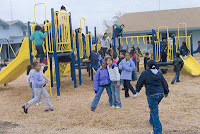Doctoral Research on Bullying, Pt. 2
By DJ Skogsberg, Ed.D.
School Culture - Visions, Missions, and Touchstones
Practitioners and researchers have consistently opined that a shared vision of an organization at its inception is what allows an organization to grow and thrive. Fullan, et.al. (1990) noted, specifically, that this is the foundation of school improvement. Synonymously, the State University of New York at Albany noted that the “district-level vision is clearly articulated in terms of what it looks like in classrooms and how it will affect student achievement” (Wilcox and Angelis, 2007, p. 19), thus guiding school improvement in terms of both culture and academic performance. Elbot and Fulton (2008) specifically identified the differences between a vision, mission, and touchstone. The vision of an organization “states its goals” where as the mission of an organization “states the purpose of the organization.” A touchstone, however, “expresses the ‘how’ of the organization” (2008, p. 18).
Schein, as cited in Kariuki (2008, p. 25), defined culture as the “deeper level of basic assumptions, values, and beliefs that become shared and taken granted for as the organization continues to be successful.” Logically, then, the vision, mission, and touchstone are interwoven threads that shape and form the tapestry of the school and is known as the school’s culture. School culture is something that is felt. More specifically, school culture is something that can be observed. Think of each component as another lens of focus with which to look through. Observing goals through a global perspective emphasizes the codependency. Goals are driven by the mission, and the goals drive the mission. The touchstone, however, is not long term in its focus like its counterparts-the vision and mission. Elbot and Fulton posited that the touchstone is, “both academic and ethical-that a school community seeks to develop in its members, and it serves as a guide for daily thinking and action” (2008, p. 2). In keeping with the analogy of a tapestry, the touchstone is the common thread that holds the culture together and takes its community members to task.
Some recent action research supported this premise. One of the premier districts in implementing touchstones, Summit School District in Frisco, Colorado, took the lead to “incorporate a shared set of universal values and aspirations for all members of the school community” to hold the district together and “keep them focused, even during turbulent times” (2009, p. 1). The distillation of each school’s touchstone included the collaboration of all stakeholders, especially the active participation of students. Appelsies and Fairbanks made specific note of student ownership within the culture of a building, quoting students in their observations, “[t]his is where we work together” “[t]his is where we help each other,” and “[t]his is where we conversate” (1997, p. 70).
The action research by Appelsies and Fairbanks (1997) noted that part of what we called “school culture” and “student ownership” in the building was reflective of a fostered, democratic environment, a premise that was of vital importance for adolescents to experience as they lived through this stage of intellectual maturation. The fostered, democratic environment linked the aforementioned needs of developing adolescents. The question remained then, how did each stakeholder play a role in school culture?
Change of School Culture & Change in Theory:
With any change process, there is an inherent feeling that something is “wrong.” Simpson echoed the connotation “that culture and change are antithetical, that change threatens stability, predictability, and comfort of the culture” (1990, p. 35). Fullan (1993) emphasized that if the change process was addressed as a political process, what stakeholders faced was stagnation, frustration, discontent, disconnectedness, defensiveness, and superficial changes that resulted in a return to the status quo.
Change, while constant, is not nearly as difficult for adolescents as we educators claim it to be. Children, even those wrought with significant physiological, psychological, and sociological shifts (i.e. adolescents) are still malleable and able to be guided through these changes.
Ownership, Empowerment, and Stakeholders:
If we recognize that the change process as a whole, let alone the change of a school culture, is an ongoing process-a living entity analogous to the concept of the Constitution of the United States-then we have to accept that culture and the process of change must be nurtured. Research repeatedly noted buy-in from all stakeholders and lists those in the school community as administrators, teachers, non-certified staff, parents/guardians, and community members. Unfortunately, and of particular concern for the children impacted by this perceived bias, the students were consistently ignored, yet they were impugned for changes while being excluded from the change process itself. This seemed to be in direct contradiction to published research by Fullan (1999) which focused on collaborative cultures that fostered diversity while building trust, provoked anxiety and contained it, engaged in knowledge creation, combined connectedness with open-endedness, and fused the spiritual, political, and intellectual (p. 37). How can we possibly foster collaborative cultures when students are not given ownership in their school, in part or in whole, with any initiative?
Dorman, et.al (1985) raised this point regarding adolescents and their role in schools and developmental needs, which specifically called for “diversity, self-exploration and self-definition, meaningful participation in their schools and communities, positive social interaction with peers and adults, physical activity, competence and achievement, and structure and clear limits” (p. 46). Research conducted by Way, Reddy & Rhodes (2007) emphasized the tenet that students’ beliefs during middle school years formed the base from which they would grow into adulthood and be positive or negative. This was specifically true as it related to students perceiving a sense of autonomy and having the opportunity for autonomy. The researchers found “the intercept of opportunities for student autonomy was significantly associated with the intercept of depressive symptoms and self-esteem and the intercept and slope of behavior problems” (Way, Reddy & Rhodes, 2007, p. 206). This direct correlation between student autonomy and behavior problems indicated that there was a significant impact on school culture whether or not students perceived that they had autonomy. The key was that the students had the opportunity to be autonomous. Way, et.al. emphasized that “students’ beliefs of the school climate appeared to be important not just during the transition from elementary to middle school, but also during middle school itself” (2007, p. 209).
Taking the First Step:
There is clearly no simple answer to addressing bullying. We continuously see adults modeling bullying behavior for children. And so, if we must begin with a first step, let it begin with us. Be the model held to the higher standard, performing well above the expectations you have for your students (or children). Empower students to take an active role in their school by granting them ownership in their actions, the actions of their peers, and the consequences (good, bad, or indifferent) that naturally follow. Stop marginalizing children. If we want students to step up, sometimes it requires of us to give them a boost. And so, if the first step in stomping out bullying rests on the shoulders of the adult stakeholders, the real question is, do you have the courage to “take a step off the porch” (Poole, 2003)?
Download the research and works cited here:
http://www.schoolimprovement.com/docs/120526-Bullying-Beyond-the-Playground-for-School-Improvement-Network.pdf
*****
For more information on bullying prevention and available resources to support your efforts, sign up today for the FREE professional development webinar for educators presented by the School Improvement Network, Bullying: Understanding the Problem, Defining Solutions on May 30th 2012, 3:00pm with Robin Young of the National Crime Prevention Council.
Click here to register for the FREE webinar:
http://www.instantpresenter.com/AccountManager/RegEv.aspx?PIID=EA57D783884f


















